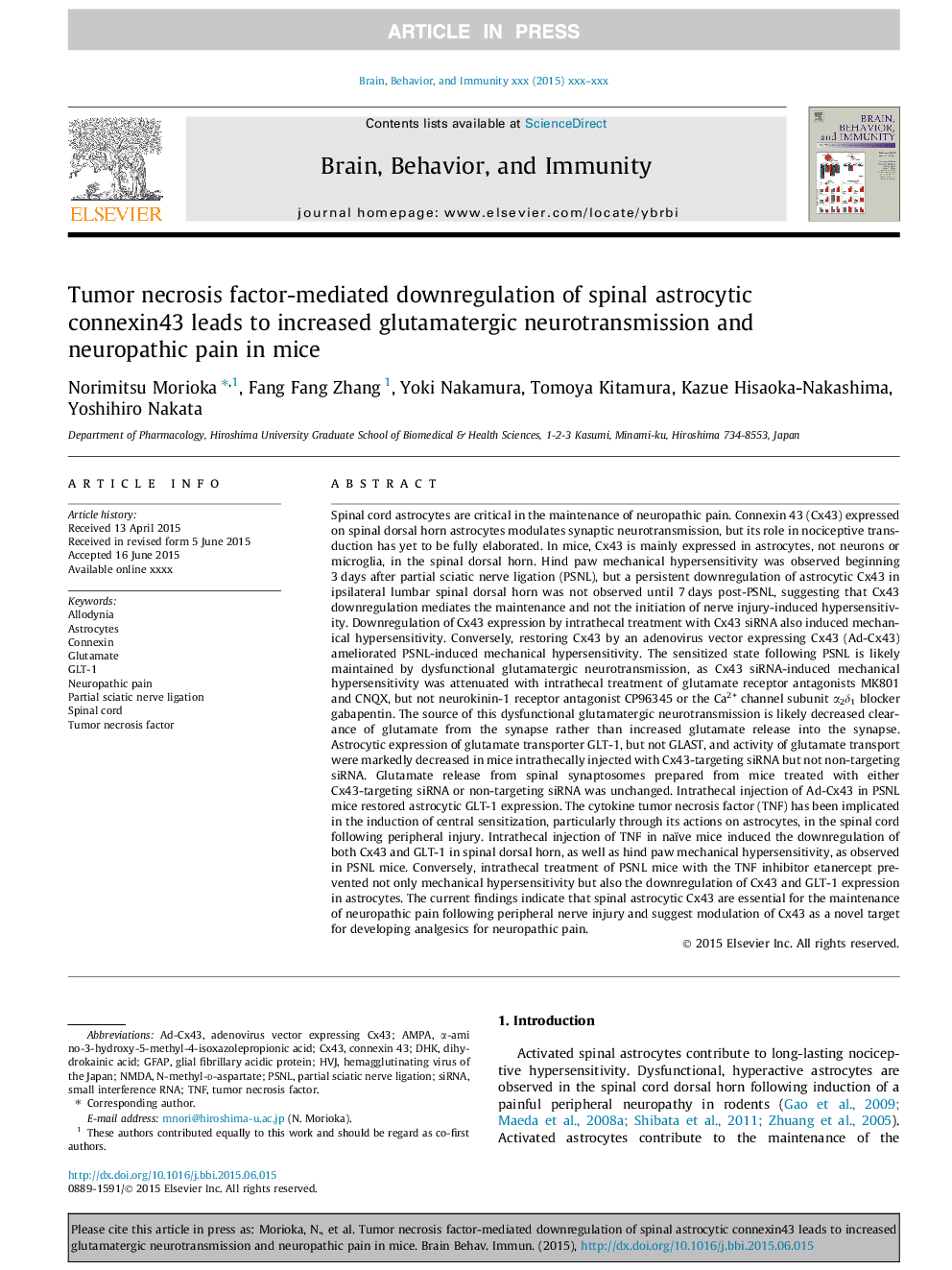| کد مقاله | کد نشریه | سال انتشار | مقاله انگلیسی | نسخه تمام متن |
|---|---|---|---|---|
| 7280897 | 1473918 | 2015 | 18 صفحه PDF | دانلود رایگان |
عنوان انگلیسی مقاله ISI
Tumor necrosis factor-mediated downregulation of spinal astrocytic connexin43 leads to increased glutamatergic neurotransmission and neuropathic pain in mice
ترجمه فارسی عنوان
کاهش غلظت عامل ناباروری تومور در کانکسین آستروسیتیک ستون فقرات 43 منجر به افزایش انتقال نوروتراپی گلوتاماترگیک و درد نوروپاتیک در موش می شود
دانلود مقاله + سفارش ترجمه
دانلود مقاله ISI انگلیسی
رایگان برای ایرانیان
کلمات کلیدی
موضوعات مرتبط
علوم زیستی و بیوفناوری
ایمنی شناسی و میکروب شناسی
ایمونولوژی
چکیده انگلیسی
Spinal cord astrocytes are critical in the maintenance of neuropathic pain. Connexin 43 (Cx43) expressed on spinal dorsal horn astrocytes modulates synaptic neurotransmission, but its role in nociceptive transduction has yet to be fully elaborated. In mice, Cx43 is mainly expressed in astrocytes, not neurons or microglia, in the spinal dorsal horn. Hind paw mechanical hypersensitivity was observed beginning 3 days after partial sciatic nerve ligation (PSNL), but a persistent downregulation of astrocytic Cx43 in ipsilateral lumbar spinal dorsal horn was not observed until 7 days post-PSNL, suggesting that Cx43 downregulation mediates the maintenance and not the initiation of nerve injury-induced hypersensitivity. Downregulation of Cx43 expression by intrathecal treatment with Cx43 siRNA also induced mechanical hypersensitivity. Conversely, restoring Cx43 by an adenovirus vector expressing Cx43 (Ad-Cx43) ameliorated PSNL-induced mechanical hypersensitivity. The sensitized state following PSNL is likely maintained by dysfunctional glutamatergic neurotransmission, as Cx43 siRNA-induced mechanical hypersensitivity was attenuated with intrathecal treatment of glutamate receptor antagonists MK801 and CNQX, but not neurokinin-1 receptor antagonist CP96345 or the Ca2+ channel subunit α2δ1 blocker gabapentin. The source of this dysfunctional glutamatergic neurotransmission is likely decreased clearance of glutamate from the synapse rather than increased glutamate release into the synapse. Astrocytic expression of glutamate transporter GLT-1, but not GLAST, and activity of glutamate transport were markedly decreased in mice intrathecally injected with Cx43-targeting siRNA but not non-targeting siRNA. Glutamate release from spinal synaptosomes prepared from mice treated with either Cx43-targeting siRNA or non-targeting siRNA was unchanged. Intrathecal injection of Ad-Cx43 in PSNL mice restored astrocytic GLT-1 expression. The cytokine tumor necrosis factor (TNF) has been implicated in the induction of central sensitization, particularly through its actions on astrocytes, in the spinal cord following peripheral injury. Intrathecal injection of TNF in naïve mice induced the downregulation of both Cx43 and GLT-1 in spinal dorsal horn, as well as hind paw mechanical hypersensitivity, as observed in PSNL mice. Conversely, intrathecal treatment of PSNL mice with the TNF inhibitor etanercept prevented not only mechanical hypersensitivity but also the downregulation of Cx43 and GLT-1 expression in astrocytes. The current findings indicate that spinal astrocytic Cx43 are essential for the maintenance of neuropathic pain following peripheral nerve injury and suggest modulation of Cx43 as a novel target for developing analgesics for neuropathic pain.
ناشر
Database: Elsevier - ScienceDirect (ساینس دایرکت)
Journal: Brain, Behavior, and Immunity - Volume 49, October 2015, Pages 293-310
Journal: Brain, Behavior, and Immunity - Volume 49, October 2015, Pages 293-310
نویسندگان
Norimitsu Morioka, Fang Fang Zhang, Yoki Nakamura, Tomoya Kitamura, Kazue Hisaoka-Nakashima, Yoshihiro Nakata,
